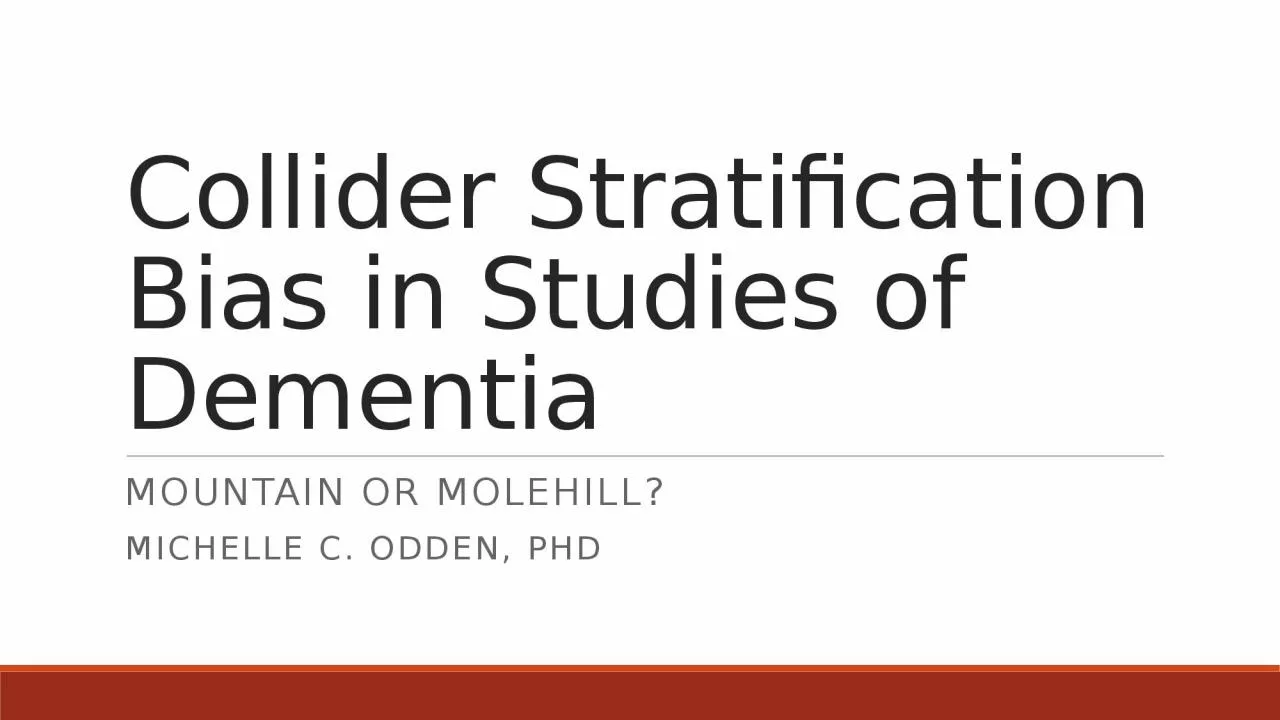

Mountain or Molehill Michelle C Odden PhD Outlines Definitions and DAGs Quantifying the bias Should we be worried Discussion Definitions amp DAGs Confounding Bias Exposure Outcome Confounder ID: 917312
Download Presentation The PPT/PDF document "Collider Stratification Bias in Studies ..." is the property of its rightful owner. Permission is granted to download and print the materials on this web site for personal, non-commercial use only, and to display it on your personal computer provided you do not modify the materials and that you retain all copyright notices contained in the materials. By downloading content from our website, you accept the terms of this agreement.
Slide1
Collider Stratification Bias in Studies of Dementia
Mountain or Molehill?
Michelle C. Odden, PhD
Slide2Outlines
Definitions and DAGs
Quantifying the bias
Should we be worried?Discussion
Slide3Definitions & DAGs
Slide4Confounding Bias
Exposure
Outcome
Confounder
Slide5Confounding Bias
Exposure
Outcome
Confounder
Slide6Collider Stratification Bias
Exposure
Outcome
Selection
Slide7Collider Stratification Bias
Exposure
Outcome
Selection
Hernan, M. et al. A Structural Approach to Selection Bias. Epidemiology. 2004.
Slide8Collider Stratification Bias
Rich
Funny
My party
?
*Example stolen shamelessly from Maria Glymour circa 2010
Slide9Collider Stratification Bias
Gene
Dementia
Nursing Home
Resident
?
Slide10Berkson’s Bias
Gallbladder Disease
Diabetes
Hospital
?
Slide11M-Bias
Gene
Smoking
Nursing Home
Resident
?
Obesity
Dementia
Slide12M-Bias
Gene
Smoking
Nursing Home
Resident
?
Obesity
Dementia
Slide13Quantifying the bias
Slide14Quantifying the Bias - Greenland
In the setting of collider stratification bias:
For any RR = RR
SE = RRSO = 2, 4, 5, 16, the respective maximal biases are only 1.13, 1.56, 2.53, 4.52These are attenuated if RRSE
≠
RR
SO
In the setting of M-bias:
For any RR
=
2, 4, 5, 16, the respective maximal biases are only 1.003, 1.05, 1.23, 1.68
These are attenuated
if the RR is not constant
Greenland, S. Quantifying Biases in Causal Models: Classical Confounding vs Collider-Stratification Bias. Epidemiology, 2003
Slide15Quantifying the Bias - Pizzi
When all three RR (arrows) were set to RR=4), the magnitude of the bias was 0.15
When all three RR were set to RR=2, the bias dropped to 0.02
Pizzi
, C. Sample selection and validity of exposure-disease association estimates in cohort studies. J
Epidemiol
Comm
Health. 2010
Slide16Quantifying the Bias -
Liu
Liu W, et al. Implications of M Bias in Epidemiologic Studies: A Simulation Study. Am J
Epidemiol. 2012.
Slide17Quantifying the Bias - Glymour
Commentary in response to article proposing that RR of 0.7 of obesity on death among heart failure patients is due to selection
Selection
hypothesis – conditioning on heart failure induces selection bias by presence of unmeasured risk factors
Opposite effects hypothesis – heart failure qualitatively transforms the consequences of obesity
Glymour and
Vittinghoff
. Selection Bias as an Explanation for the Obesity Paradox. Epidemiology, 2014.
Slide18Quantifying the Bias - Glymour
Glymour and
Vittinghoff
. Selection Bias as an Explanation for the Obesity Paradox. Epidemiology, 2014.
Slide19Quantifying the Bias - Glymour
Glymour and
Vittinghoff
. Selection Bias as an Explanation for the Obesity Paradox. Epidemiology, 2014.
Slide20Quantifying the Bias - Odden
High Blood Pressure
Cognitive Impairment
Old/Frail
?
Unmeasured
Slide21Quantifying the Bias - Odden
High Blood Pressure
Cognitive Impairment
Old/Frail
?
Unmeasured
High Blood Pressure
In old age
Slide22Quantifying the Bias - Odden
Odden et al.
Patterns of Cardiovascular Risk Factors in Old Age and Survival and Health Status at
90. JGMS, 2020.
Slide23Quantifying the Bias - Odden
High Blood Pressure
Death
Frail
Unmeasured
High Blood Pressure
In old age
Slide24Should we be worried?
Slide25Should we be worried?
Risk Factor
Prevalent Dementia
Old Age
Slide26Estimates from Greenland suggest not much
In the setting of collider stratification bias:
For any RR = RR
SE = RRSO = 2, 4, 5, 16, the respective maximal biases are only 1.13, 1.56, 2.53, 4.52
Greenland, S. Quantifying Biases in Causal Models: Classical Confounding vs Collider-Stratification Bias. Epidemiology, 2003
Slide27Should we be worried?
Risk Factor
Dementia
Old
Unmeasured
Slide28Estimates from Pizzi suggest no
Pizzi
, C. Sample selection and validity of exposure-disease association estimates in cohort studies. J
Epidemiol
Comm
Health. 2010
Slide29Should we be worried?
Risk Factor
Dementia
Old Age
Unmeasured
Risk Factor
in old age
Slide30Estimates from Glymour suggest not much
Glymour and
Vittinghoff
. Selection Bias as an Explanation for the Obesity Paradox. Epidemiology, 2014.
But old age could affect risk factor and alter the effects of the risk factor (effect modification)
Slide31My take on the literature
Collider bias, which affects prevalent disease studies, appears to be only an important source of bias (>10%) if the RR of selection of both risk factor and dementia on selection exceed 2
M-bias, which can affect incident disease studies, appears to be only an important source of bias (>10%) if the RR of selection and unmeasured confounding exceed 4
Old age could affect risk factor levels and alter the effects of the risk factor, so generalizability remains a key consideration
Slide32Thank you and discussion
modden@Stanford.edu